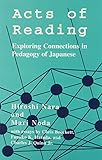Acts of Reading : Exploring Connections in Pedagogy of Japanese / Mari Noda, Hiroshi Nara.
Material type: TextPublisher: Honolulu : University of Hawaii Press, [2002]Copyright date: ©2002Description: 1 online resource (344 p.)Content type:
TextPublisher: Honolulu : University of Hawaii Press, [2002]Copyright date: ©2002Description: 1 online resource (344 p.)Content type: - 9780824822613
- 9780824861377
- 495.68007 22
- PL519 .N325 2003eb
- online - DeGruyter
- Issued also in print.
| Item type | Current library | Call number | URL | Status | Notes | Barcode | |
|---|---|---|---|---|---|---|---|
 eBook
eBook
|
Biblioteca "Angelicum" Pont. Univ. S.Tommaso d'Aquino Nuvola online | online - DeGruyter (Browse shelf(Opens below)) | Online access | Not for loan (Accesso limitato) | Accesso per gli utenti autorizzati / Access for authorized users | (dgr)9780824861377 |
Frontmatter -- Contents -- Foreword -- Acknowledgments -- Introduction -- Part 1: Reading as a Cultural Act -- Chapter 1. Learning to Read as a Native Speaker -- Chapter 2 . Reading as a Social Activity -- Chapter 3. Taking It from the Top: The Growth and Care of Genres -- Part 2: Theoretical Orientation -- Chapter 4. The Foreign Language Learner -- Chapter 5. Toward a Theoretical Understanding of Reading -- Chapter 6. The View from Cognitive Neuroscience -- Part 3: Implementation -- Chapter 7. Designing a Reading Program -- Chapter 8. Implementation of Reading in the Classroom -- Chapter 9. Evaluation in Reading -- Chapter 10. Selection and Development of Learning Materials -- Chapter 11. Adopting High Technology in Developing Teaching Materials -- Notes -- References -- Contributors -- Indexes
restricted access online access with authorization star
http://purl.org/coar/access_right/c_16ec
Students who have completed a year of German read Brecht in their second year, those of Spanish read Cervantes. Teachers of first and second-year Japanese can often find nothing comparable. "Why aren't your students reading literature?" they are asked. "Why not Soseki? Or Murakami?" What are instructors of Japanese doing wrong?Nothing, according to the authors of this volume. Rather, they argue, such questions exemplify the gross misunderstandings and unreasonable expectations of teaching reading in Japanese. In Acts of Reading, the authors set out to explore what reading is for Japanese as a language, and how instructors should teach it to students of Japanese. They seek answers to two questions: What are the aspects of reading in Japan as manifested in Japanese society? What L2 (second-language) reading problems are specific to Japanese? In answering the first and related questions, the authors conclude that reading is a socially motivated, purposeful act that is savored and becomes a part of people's lives. Reading instruction in Japanese, therefore, should include teaching students how to work with text as the Japanese do in Japanese society.The second question relates more directly to traditional concerns in L2 reading. The authors begin with a general theory of reading. They then offer a welcome glimpse into the rich and complex perspectives-sometimes conflicting, other times symbiotic-on what reading is and how it is performed in L1 and L2, and, most importantly, on the web of interconnections between the phenomenology of reading and the demands it places on teaching approaches to reading in Japanese.With essays by Charles J. Quinn, Jr., Fumiko Harada, and Chris BrockettForeword by J. Marshall Unger
Issued also in print.
Mode of access: Internet via World Wide Web.
In English.
Description based on online resource; title from PDF title page (publisher's Web site, viewed 02. Mrz 2022)


